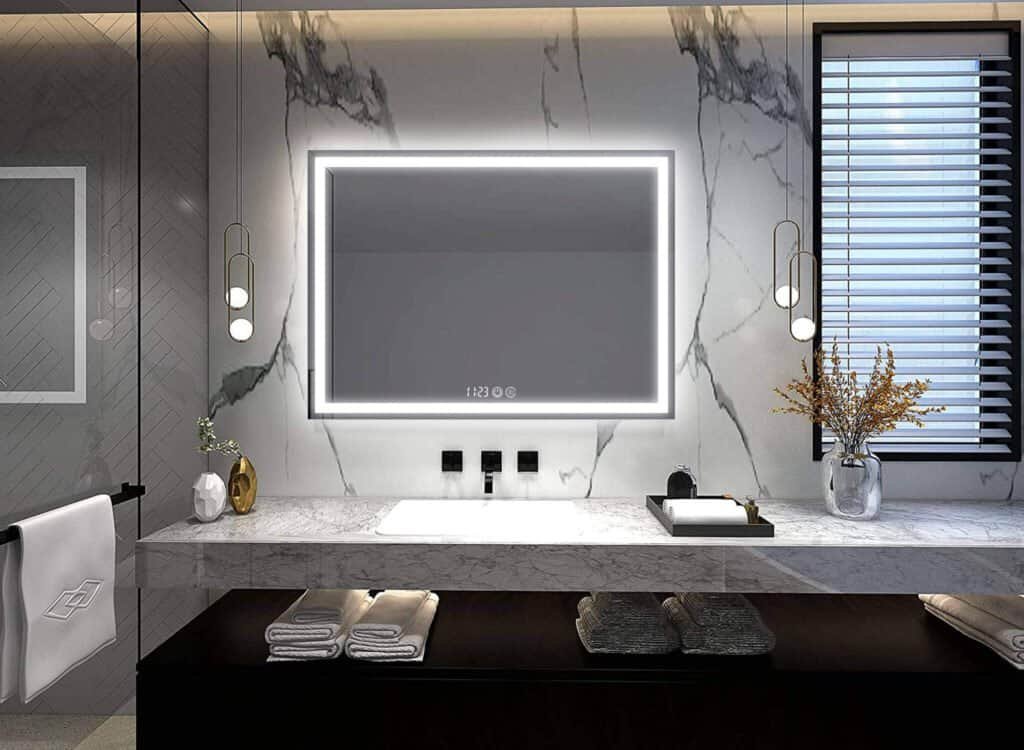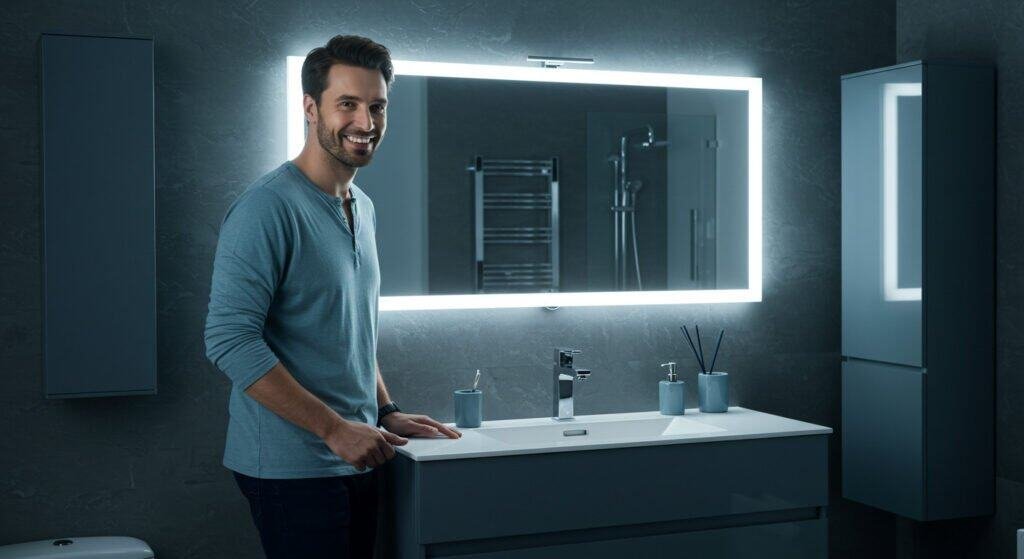Incorrect bathroom mirror placement over vanity can create daily frustrations, from poor lighting angles to awkward viewing positions. Many homeowners struggle with determining the optimal bathroom mirror height, leading to installations that compromise both functionality and aesthetic appeal.
The standard bathroom vanity mirror height should position the mirror’s bottom edge 5-10 inches above the vanity countertop, with the mirror’s center aligning with the average eye level of users, typically 60-65 inches from the floor. This placement of bathroom mirror ensures comfortable daily use while maintaining proper proportions within the bathroom space.
Understanding the technical aspects and design principles behind proper vanity mirror placement will help you achieve both optimal functionality and visual harmony in your bathroom renovation project.
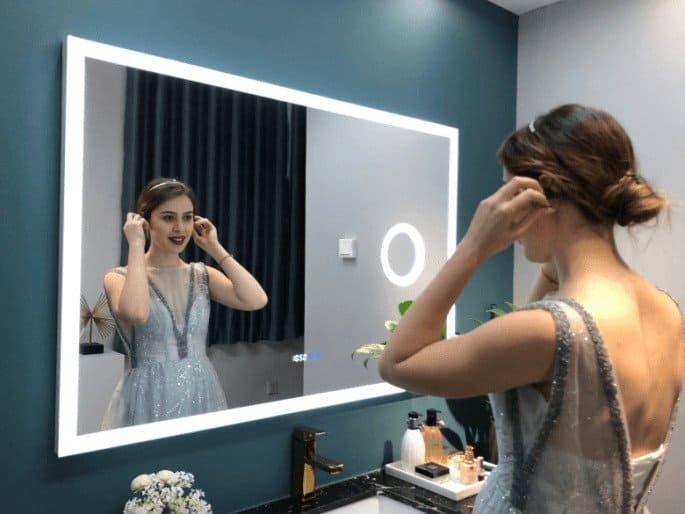
What Factors Determine the Ideal Mirror Height?
Several critical variables play into the ideal placement of a bathroom mirror over a vanity. It depends on some user demographics and spatial constraints.
Primary factors include user height, vanity dimensions, mirror size, and ceiling height. The bathroom vanity mirror height must accommodate the tallest regular user while remaining accessible to shorter family members.
The relationship between these elements will dictate the final installation height. Standard vanity countertops are 32-36 inches from the floor, and the average user’s eye level is typically 58-68 inches when standing. Most modern lighted mirrors for bathrooms have adjustable mounting systems that allow you to fine-tune the height after installation.
When considering the installation of an LED bathroom mirror with integrated lighting, you will need to account for additional clearances for electrical connections and heat dissipation. Also, depending on the frame size, you’ll need to calculate the height with the frame in mind. If you have a black framed vanity mirror or have added a decorative border that extends beyond the reflective surface, you’ll need to adjust your calculations.
What Are the Rules for Mirror Placement?
Professional installation guidelines set specific vanity mirror height standards to ensure safety, functionality, and code compliance.
Industry standards recommend maintaining 4-6 inches minimum clearance between mirror edges and wall-mounted fixtures, with the mirror positioned centrally above the vanity. Bathroom mirror height should never exceed 80% of the available wall space vertically.
The fundamental rule is that everything in the bathroom is proportional to itself. If you have a rectangular shaped bathroom mirror, it should be 60-70% the width of the vanity to look good visually. Led mirror light strips and fixtures installed on or around mirrors must comply with electrical codes because of the moisture and wet location issues. Lighted vanity mirrors for bathrooms have to meet IP44 rating standards for wet location installations.
Wall mirror with lights configurations should position light sources to minimize shadows on the user’s face. Small bathroom mirror installations in compact spaces may require adjusted proportions, with the mirror extending closer to side walls. The backlit mirror mounting height should consider light distribution patterns to optimize illumination effectiveness across the entire reflection area.
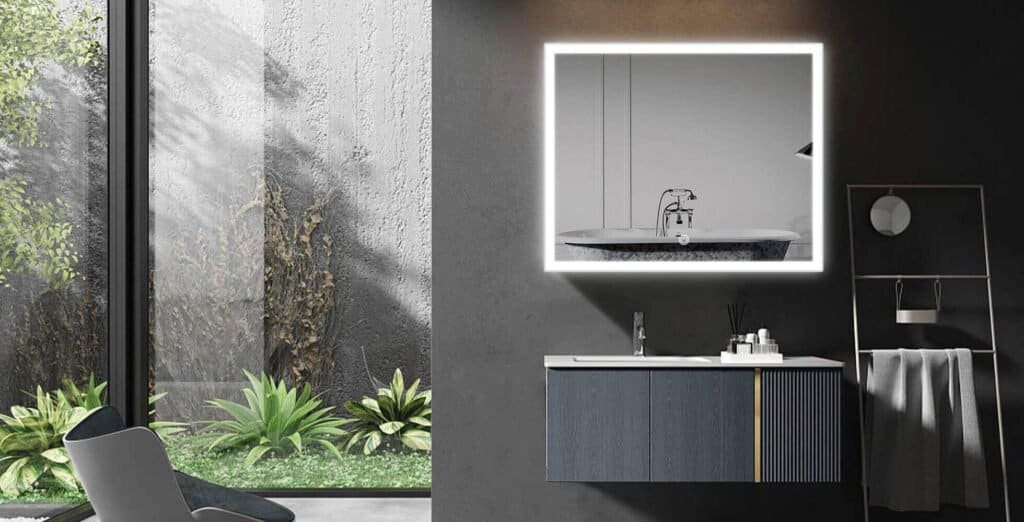
How Does Vanity Height Affect Mirror Placement?
Vanity size will directly affect the best height for the bathroom vanity mirror. The height over the vanity must be calculated differently based on the elevation of the countertop and any storage accommodations.
Standard 32-inch vanities require mirror bottom edges positioned 37-42 inches from floor level, while comfort-height 36-inch vanities need mirrors starting at 41-46 inches. This ensures proper sight lines regardless of vanity specifications.
The growing popularity of comfort-height vanities in modern bathroom designs has noticeably changed the mirror placement equation. When installing a bathroom light mirror over a vanity under these elevated conditions, you need to make adjustments to ensure it remains at the proper, ergonomic viewing height. Installing an LED bathroom light mirror in combination with a comfort-height bathroom vanity is a great option because the integrated lighting overcomes any resulting shadowing issues from raising the mirror.
When you mount a lighted makeup mirror above a comfort-height vanity, it should have an adjustable tilting mechanism to optimize your view for detailed grooming tasks. Most modern led bathroom mirror designs include adjustable mounting brackets so you can use the mirror over vanities that aren’t a standard height without requiring custom fabrication.
| Vanity Height | Mirror Bottom Edge | Center Height | Top Edge Maximum |
|---|---|---|---|
| 30 inches | 35-40 inches | 55-60 inches | 75 inches |
| 32 inches | 37-42 inches | 57-62 inches | 77 inches |
| 34 inches | 39-44 inches | 59-64 inches | 79 inches |
| 36 inches | 41-46 inches | 61-66 inches | 81 inches |
Where to Hang Bathroom Mirror for Optimal Results?
Strategic mirror placement in a bathroom considers natural light, where you put the artificial light, and where people will move around in the bathroom.
Position mirrors to capture and reflect natural light from windows while avoiding direct sunlight that creates glare. Center the mirror above the vanity with equal spacing on both sides for balanced proportions.
A lighted mirror over the vanity should help reflect as much natural and artificial light around the bathroom as possible. Moreover, installing a lighted vanity mirror over your bathroom vanity is easier if you’re tying into existing electrical rough-ins, making wiring less complicated. If you’re installing a vanity mirror with led lights, you’ll also want a location where you can properly manage the wires in the wall as well.
The best solution is to mount a light up vanity mirror so it reflects light out into the center of the room and doesn’t shine light back on you. When considering room mirror ideas for bathrooms, some people use multiple bathroom mirrors to reflect light back and forth and help open up the space. If you’re wondering how to position a led vanity mirror, you also need to consider the heat sinks and make sure you have plenty of ventilation space above the fixture.

How to Choose a Wall Mirror Size That Fits Your Space?
Proper sizing is imperative. The best proportion is mostly determined by the width-wise dimensions of the vanity, but overall, the mirror size should be proportional to the space and fit aesthetically within the room.
Select mirrors measuring 60-70% of vanity width for single-sink installations, while double-sink vanities accommodate either one large mirror spanning the entire width or two separate mirrors, each covering 80% of individual sink areas.
When sizing a mirror, you’re sizing it to fit the space that is available. What many people don’t think about is if you install a lighted bathroom mirror, you need a larger space for the mirror because of the heat and electrical components inside the unit. If you’re looking at led mirror sizing considerations, you’ve got to think about where the light is going to shine and if it is going to shine across the entire vanity surface area you want lit for grooming. The dimensions of the frame and the mounting hardware need to be considered as well.
The caveat is that if lights are outside the mirror, you have to allow space for those separate fixtures. What’s available in between may limit how big the mirror can be. With a glass mirror you can do anything you want, but for framed mirrors you’re restricted by what’s able to be manufactured and shipped to you. Finally, today’s modern lighted mirrors for bathrooms have slim profiles, with the whole mirror being the reflective surface.
| Vanity Width | Single Mirror Size | Double Mirror Option | Frame Clearance |
|---|---|---|---|
| 24 inches | 18-20 inches | N/A | 2 inches each side |
| 30 inches | 22-24 inches | N/A | 3 inches each side |
| 48 inches | 36-40 inches | Two 18-inch mirrors | 4 inches each side |
| 60 inches | 42-48 inches | Two 22-inch mirrors | 6 inches each side |
| 72 inches | 50-56 inches | Two 26-inch mirrors | 8 inches each side |
Do Mirrors Have to Match Vanity Design?
Coordination of your mirror and your vanity makes the whole bathroom look great. There’s a fine balance between matching and getting what you need for a specific purpose.
Mirrors do not require exact matching with vanity finishes, but should complement the overall design theme through coordinated materials, colors, or style elements. Contrasting elements can create visual interest when executed thoughtfully.
In today’s bathroom designs, people are using mixed materials and finishes, creating a very sophisticated looking, layered room. In a bathroom with a black-framed mirror, if there’s any other black anywhere in the space from the doorknob to the sink and faucet, you can get away with having a black frame on the mirror. Another trending option is using a led bathroom mirror with a very minimal frame that would go with a modern vanity.
Lighted vanity mirrors coordinate well with contemporary vanities featuring clean lines and geometric forms. Traditional vanities pair effectively with ornate mirror frames, while sleek modern vanities benefit from frameless or minimally framed mirror designs. The key principle involves maintaining consistent design intent rather than literal material matching.
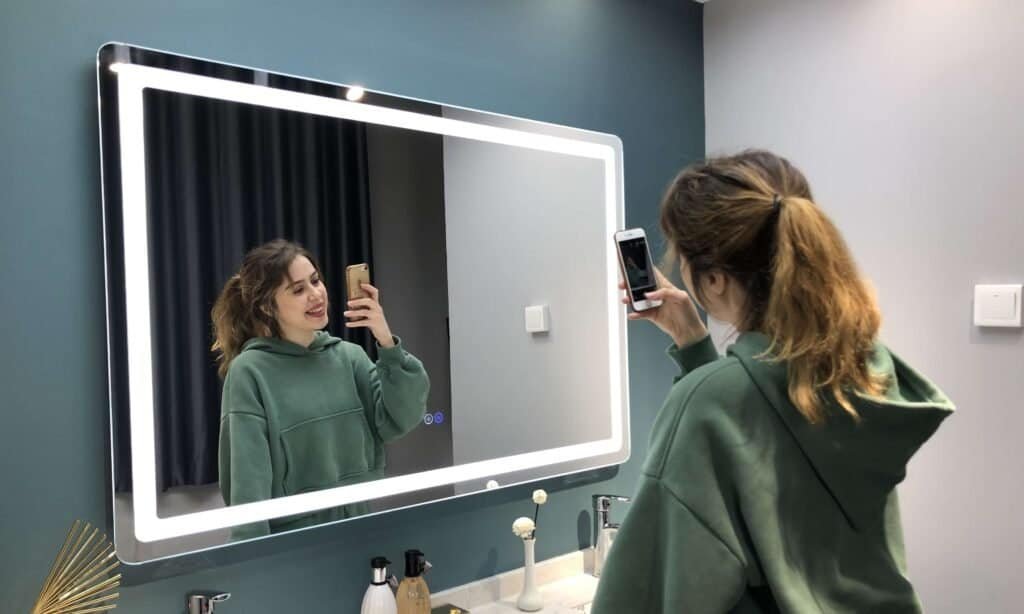
How High Should Mirror Be Above Dresser in Connected Spaces?
When you have drapes in a bathroom – a dressing table or a vanity piece that might expand the length of the vanity top, you need to think about both how high the surfaces are and what else will be taking place in that area.
Position mirrors above dresser areas at 36-42 inches above the dresser surface, typically resulting in 66-72 inches from floor level, accounting for the different user postures associated with dresser-based activities versus vanity grooming.
In a combined bathroom and dressing area, a situation I see most often in nice houses with a lot of space, you really have to compromise. If you’re planning to put lighted makeup mirror above the vanity in an environment like this, the mounting mechanism will likely need to function in an adjusted position to support use while seated as well as use while standing. When considering vanity lights positioning for a dressing area, think about how to add task lighting to the process of getting dressed and coordinating accessories.
Led light mirror configurations work particularly well in these hybrid spaces, providing consistent illumination across multiple activity zones. The bathroom vanity lights may require supplementation with dedicated dresser lighting to ensure adequate illumination for all intended functions.
Are Large Bathroom Mirrors Out of Style?
The current trend is to use large mirrors in bathrooms as a practical solution, but also as a design feature, especially in contemporary and transitional bathroom designs.
Large bathroom mirrors remain highly fashionable and functional, with modern installations favoring oversized mirrors that maximize light reflection and create spatial expansion. Current trends emphasize clean lines and minimal frames rather than ornate traditional styles.
Oversized mirror installations serve multiple functional and aesthetic purposes in contemporary bathroom design. Large led mirror installations provide superior light distribution and eliminate the visual fragmentation created by smaller mirrors. Backlit mirror designs in large formats create dramatic lighting effects while maintaining sleek profiles.
Another thing I’ve noticed is that everyone loves big mirrors in their bathroom. The trend in modern mirrors is to have the mirror go edge to edge. Also, people are using big, lighted vanity mirror installations so they don’t have to use other task lighting. This mirrors the trend in open-concept homes, in general, where people are trying to make things more open and bring in as much light as possible.
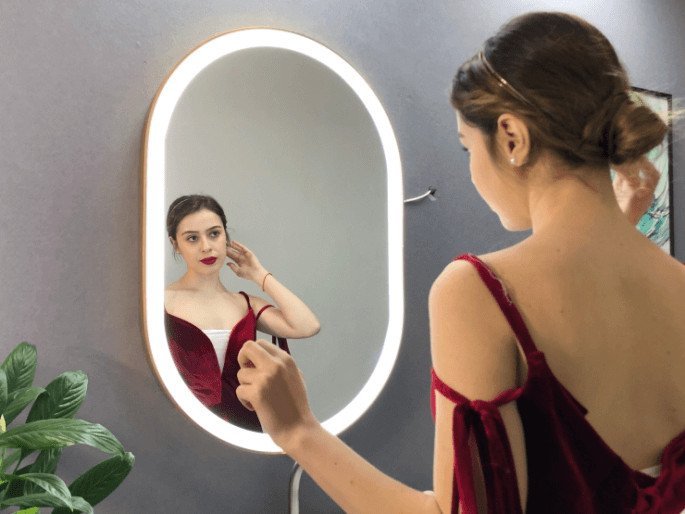
What Size Light Fixture Over Bathroom Vanity Works Best?
You need to make sure your vanity lighting dimensions are correct, and you have to be careful where you put the light so you’re not putting light onto the back of the mirror making it a mirror to reflect light.
Select vanity lights measuring 75% of mirror width for side-mounted installations, or 60% of mirror width for fixtures mounted above the mirror. Light fixtures should provide 150-300 lumens per square foot of vanity surface area.
Proper lighting integration significantly impacts mirror functionality and user experience. Bathroom vanity lights positioned above mirrors require sufficient clearance to prevent light spillage and glare issues. Led vanity mirror models with integrated lighting eliminate the need for separate fixtures while providing optimal illumination angles.
When using a lighted mirror for the bathroom, you will get better light distribution than you will with typical bathroom lights above the mirror. They typically use 3000K to 4000K LEDs in a bath makeup mirror to make sure you’re getting the best color rendering when you’re getting ready. The light mirror combo in a bath space works best if you can get light from at least two sides of the mirror so you don’t cast shadows with your face.
How to Hang Bathroom Lights Over a Mirror Properly?
Professional installation of bathroom lighting above mirrors requires clearance measurements to avoid hazards and ensure correct electrical wiring.
Mount vanity lights 75-80 inches from floor level, maintaining 6-8 inches clearance above the mirror top edge. Ensure fixtures meet IP44 moisture rating requirements and connect through GFCI-protected circuits.
Light fixture installation above mirrors presents technical challenges requiring professional electrical expertise. The led bathroom mirror installations with integrated lighting eliminate many of these complications while providing superior functionality. Lighted bathroom mirror models require only single electrical connections compared to separate mirror and light fixture installations.
Modern lighted mirrors for bathrooms often feature dimming capabilities and color temperature adjustment that external fixtures cannot match. Backlit mirror installations provide even light distribution that eliminates the harsh shadows created by overhead lighting. The light up vanity mirror technology has advanced significantly, offering reliability and energy efficiency that surpasses traditional vanity lighting solutions.
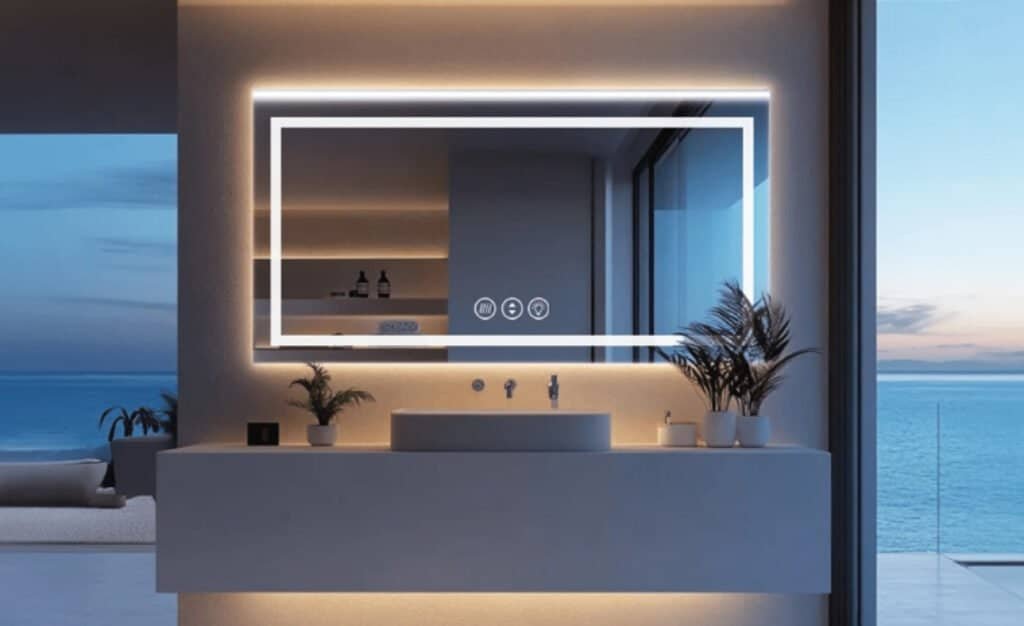
Conclusion
Proper bathroom mirror placement over the vanity is about making sure you hit all the technical specifications without derailing the aesthetics of how it will look when hung. Matching guidance for mirror height, size, and placement above the vanities will achieve you a mirror over a vanity that works.
- Clik here to know What Is Copper Free Mirror?
- If you donot know how too choose the right bathroom height click here.
- Know more about LED bathroom mirror Problems
- Clik here to know why Touch Sensor Mirror Not Working
- Clik here to know What Are Standard Vanity Mirror Sizes?
- Clik here to know Why Are Mirrors So Expensive?
- Clik here to know Do LED Mirrors Need Electricity?
- Clik here to know Is a Lighted Mirror Enough Light for a Bathroom?
- Find out 10 Common LED Bathroom Mirror Problems Click Here

